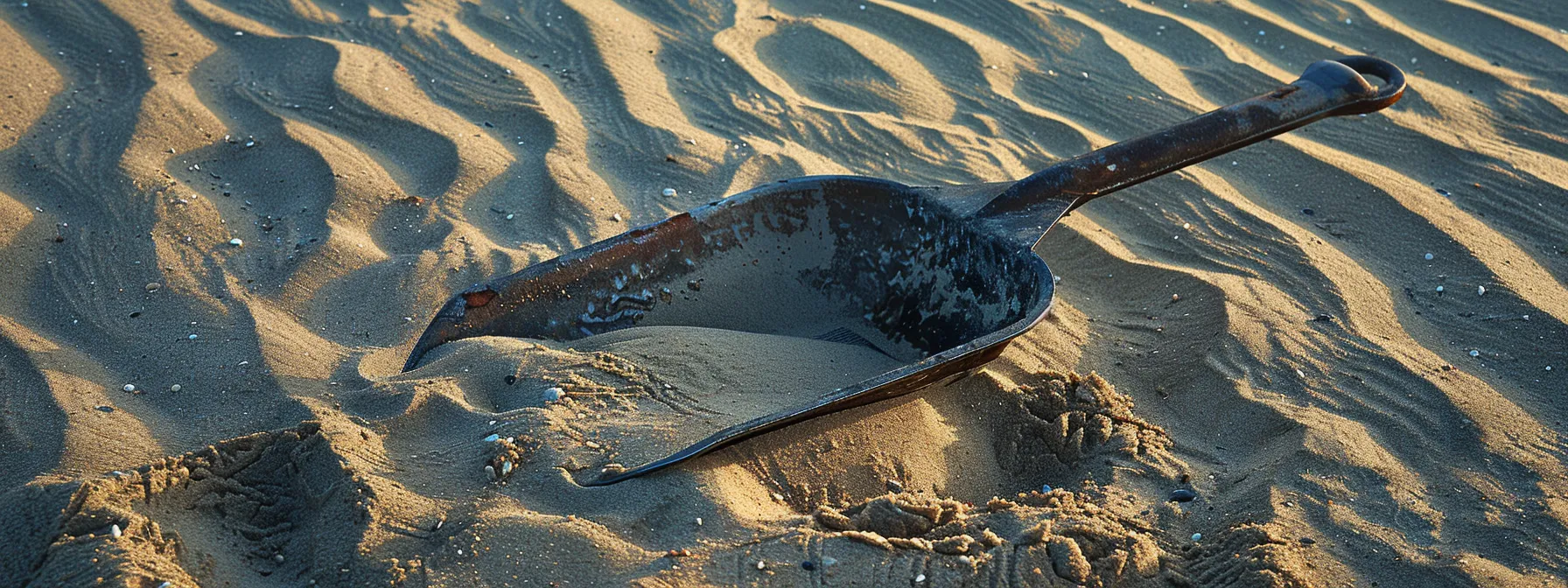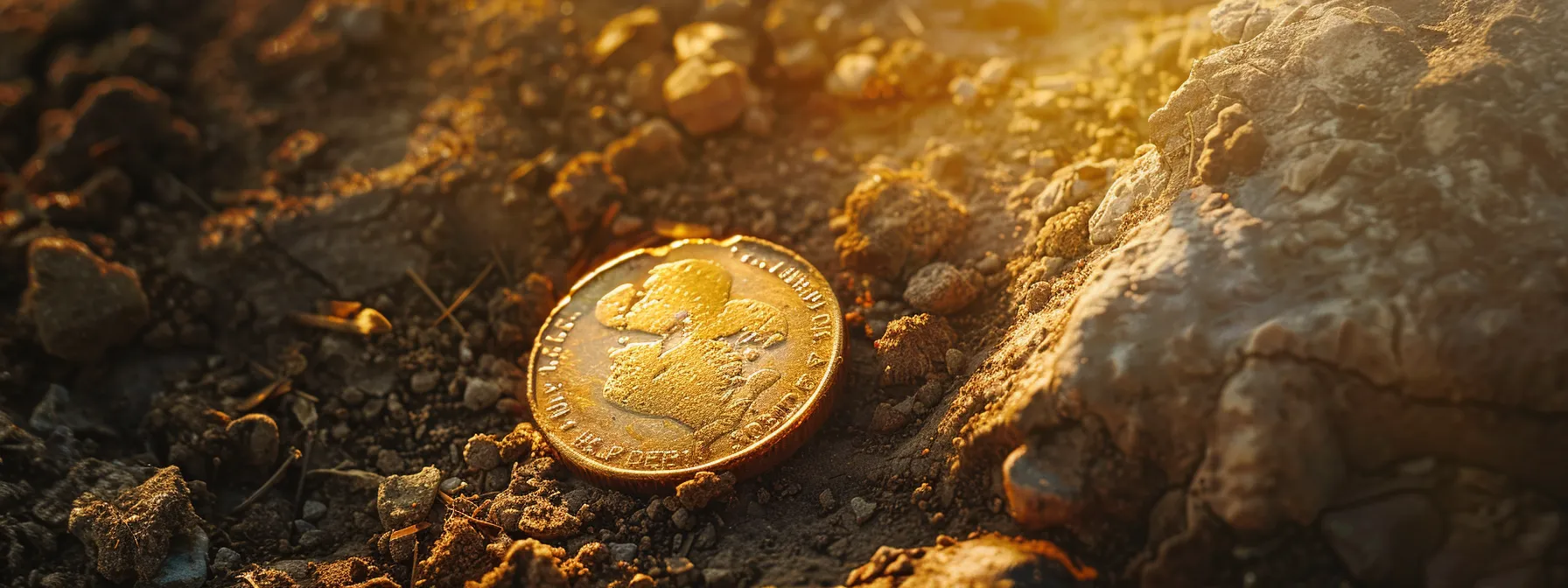

When it comes to metal detecting, a quality sand scoop can make or break your hunt. Many beginners underestimate its importance, leading to frustration when trying to dig up their finds. In this guide, we’ll explore the key features to look for in a metal detecting sand scoop, the different types suited for various conditions, and how to choose the right material—like durable stainless steel—to withstand wear and tear. By the end, you’ll feel confident in selecting the perfect sand scoop to enhance your treasure hunting experience.
Understand the Importance of a Sand Scoop in Metal Detecting

Using the Loot Detective best metal detectors, like a quality metal detecting sand scoop, is crucial for maximizing your finds. In sandy environments, challenges arise, such as losing targets to shifting sand. I’ve learned that a sturdy hexagon design in metal sand scoops can make all the difference. In the following sections, I’ll share how a great best metal detecting spots shovel scoop can enhance your treasure hunting experience. Metal Detecting Forum
Maximize Your Finds With the Right Equipment
When I hit the beach for metal detecting, having the right equipment like the best metal detectors is key to maximizing my finds. A quality sand scoop, especially one with a long handle, allows for efficient digging without bending down too much, which saves energy during long sessions. Investing in durable beach sand scoops can really pay off, as they withstand the wear and tear of saltwater and sand conditions, plus there are options available at various price points from Loot Detective, so you can find a scoop that fits your budget and needs.
- The importance of sturdy equipment.
- Benefits of using a long-handle sand scoop.
- Understanding price versus quality for beach sand scoops.
- Choosing between different sizes of scoops—like 6 inch or 9 inch.
Overcome Challenges in Sandy Environments
When detecting in sandy areas, two major challenges are the shifting soil and the potential loss of targets. Using a durable metal detector scoop, like a Loot Detective scoop made from carbon, can help you quickly sift through the sand without missing valuable finds best metal detectors. A well-constructed scoop allows for efficient extraction of Best Metal Detecting Spots while minimizing the chances of losing them in the sand, which is particularly important during busy beach days when you can easily lose track of where you’ve been digging Best Metal Detecting Spots.
| Challenge | Solution | Benefits |
|---|---|---|
| Shifting sand | Use a CKG scoop with a long handle | Reduces back strain and increases digging efficiency |
| Loss of targets | Choose a sturdy metal detector scoop made of carbon | Ensures you don’t lose valuable finds while digging |
Benefits of Using a Quality Sand Scoop
Using a quality sand scoop is vital for any metal detectorist working in sandy environments. I’ve found that scoops made of durable materials like aluminium or titanium can withstand the harsh conditions of saltwater without bending or breaking. Additionally, a sand scoop with a long handle lets me dig Best Metal Detecting Spots without straining my back, making it easier to sift through the sand efficiently and recover targets quickly. Whether you choose a plastic option for lightweight convenience or a metal scoop for added strength, investing in a Loot Detective quality scoop can significantly improve your treasure hunting success.
A good sand scoop can make the difference between a buried treasure and a wasted trip. Next, let’s explore the key features that will guide you to the right scoop for your next find.
Identify Key Features to Look for in a Metal Detecting Sand Scoop

When choosing the right metal detecting sand scoop, I focus on several key features that enhance my treasure hunting experience. First, scoop size and capacity play a big role in what I can recover. Next, evaluating hole patterns ensures efficient sifting. Comfort comes into play with the handle length, while I also balance weight with durability. Finally, always consider high-quality materials like steel, especially when looking at options such as the CKG sand scoop from the Best Metal Detecting Spots Metal Detecting Forum Best Metal Detecting Spots. A solid warranty can also provide peace of mind in my purchase. Blog Resources Loot Detective
Consider Scoop Size and Capacity
When it comes to choosing a sand scoop for metal detecting, considering the scoop size and capacity is essential. I’ve learned that a larger scoop can hold more sand and targets, allowing me to spend less time sifting and more time detecting at my favorite Best Metal Detecting Spots. However, I also look for a scoop that isn’t overly heavy, as carrying extra weight can become exhausting during a long day out. Striking the right balance between size and practicality ensures optimal performance while out in the field on the Metal Detecting Forum Blog Resources:
- Consider the size to effectively manage larger targets.
- Aim for a scoop that is light enough to carry comfortably.
- Prioritize a design that fits well with your metal detecting gear.
Evaluate Hole Patterns for Efficient Sifting
When evaluating Loot Detective sand scoops for metal detecting at Best Metal Detecting Spots, the hole patterns are crucial for efficient sifting. I’ve found that a scoop with an effective hole design allows sand and smaller debris to drain quickly while retaining targets. This is especially beneficial at Best Metal Detecting Spots, where the ground can be mixed with fine sand and larger items that might obstruct your find. Metal Detecting Forum Blog Resources
| Hole Pattern Type | Efficiency | Ideal Use |
|---|---|---|
| Large Holes | Quick drainage, less clogging | Best for sandy environments |
| Small Holes | Retention of small targets | Good for areas with small items |
| Mixed Sizes | Versatile for different debris | Effective in varied terrain |
Assess Handle Length and Comfort
When I’m out searching for treasure, I can’t overstate the importance of handle length and comfort in a metal detecting sand scoop. A scoop with a longer handle allows me to dig deeper without bending over constantly, which can really save my back on long outings. Plus, I pay attention to how the handle feels in my grip; a comfortable, non-slip handle can make a big difference when I’m working quickly on busy beach days when every second counts in locating my next find. Explore more on the Metal Detecting Forum or Blog Resources to find the best metal detectors and Best Metal Detecting Spots recommended by Loot Detective.
Balance Weight With Durability
Finding the right balance between weight and durability in the best metal detectors sand scoop can significantly impact my treasure hunting experience. A scoop that’s too heavy can wear me out quickly, especially during long sessions at the beach, while a lightweight scoop that isn’t durable might break during use. I’ve found that materials like aluminum strike a great balance; they offer the strength I need for digging through tough sand while remaining light enough to handle comfortably throughout the day.
Importance of High-Quality Materials
Choosing the best metal detectors Loot Detective from Best Metal Detecting Spots made from high-quality materials is critical for enhancing your treasure hunting efficiency Metal Detecting Forum. For example, I’ve found that aluminum and titanium scoops are not only lightweight but also incredibly resilient against the harsh conditions of the beach. Investing in a scoop made from durable materials means fewer worries about wear and tear, allowing you to focus on discovering those hidden treasures beneath the sand Blog Resources:
| Material Type | Durability | Weight |
|---|---|---|
| Aluminum | Strong and resistant to corrosion | Lightweight and easy to handle |
| Titanium | Exceptional strength and longevity | Very lightweight, perfect for extended use |
| Plastic | Good for casual use but less durable | Very light, easy to carry |
Now that you know what features matter most in a sand scoop, it’s time to see the options available. Different conditions call for different scoops, and each has its strengths.
Explore Different Types of Sand Scoops for Various Conditions

Choosing the right sand scoop for your metal detecting adventures is crucial, and different environments require different tools from best metal detectors. I’ll cover handheld scoops perfect for dry sand hunting, long-handled options for shallow water detecting from Best Metal Detecting Spots, scoops designed specifically for rocky or compact sand, and versatile scoops that can handle multiple terrains effectively. These insights from Loot Detective Metal Detecting Forum Blog Resources will help you select the perfect scoop for your next treasure hunt.
Handheld Scoops for Dry Sand Hunting
When I’m hunting in dry sand, I always reach for a handheld scoop. These scoops are lightweight and easy to maneuver, which makes them perfect for quickly sifting through the soft, loose sand. I’ve found that a well-designed handheld scoop allows me to extract targets efficiently without losing my finds to the wind or shifting sand, especially when I’m searching for coins or jewelry on the beach. Their portability means I can carry them around comfortably, so I’m always ready to dig at a moment’s notice. Check out the Metal Detecting Forum for additional tips and resources. Visit the Blog Resources for more information on the best metal detectors and Best Metal Detecting Spots.
Long-Handled Scoops for Shallow Water Detecting
When I venture into shallow waters for metal detecting, a long-handled scoop becomes an essential part of my gear. It allows me to reach down without getting completely soaked, making it easier to sift through both water and sand as I search for treasures like coins and jewelry. With a sturdy yet lightweight design, these scoops not only enable efficient digging but also reduce the strain on my back, allowing me to focus on finding those hidden gems beneath the surface. If you’re interested in more tips and tricks for metal detecting, be sure to check out the Metal Detecting Forum and Blog Resources at Loot Detective. For information about the best metal detectors and Best Metal Detecting Spots
Scoops Designed for Rocky or Compact Sand
When searching in rocky or compact sand environments, having the right scoop is essential for efficiently extracting targets. I prefer using scoops that feature reinforced edges and a sturdy design, as they can handle rough terrain without bending or breaking. These specialized scoops allow me to dig into hard-packed sand and gravel effectively, ensuring I don’t miss valuable finds buried within the stones. For more information on the best metal detectors, I recommend checking out the Loot Detective Blog Resources Best Metal Detecting Spots.
Versatile Scoops for Multiple Terrains
When I head out for metal detecting adventures, having a Loot Detective versatile scoop for multiple terrains is a game changer. These scoops are designed to adapt to varying ground conditions—whether I’m on a sandy beach, rocky shore, or compact dirt. With a scoop that features a strong build and an effective design, I can tackle different environments with ease, ensuring that I can recover treasures without constantly switching tools. This flexibility saves me time and helps me stay focused on finding those hidden gems, regardless of the conditions I encounter.
Choosing the right sand scoop matters. Let’s dive into what materials work best for your treasure hunting adventures.
Decide on the Best Material for Your Sand Scoop

Choosing the right material for your metal detecting sand scoop can dramatically affect your treasure hunting success. I’ll discuss the benefits of stainless steel construction, the pros and cons of aluminum scoops, and how plastic options can cater to beginners. Additionally, we’ll compare the durability of these materials to help you find the perfect scoop for your adventures.
Benefits of Stainless Steel Construction
Choosing a metal detecting sand scoop made from stainless steel offers significant advantages. This material is incredibly durable and resistant to corrosion, making it ideal for harsh saltwater conditions. I’ve found stainless steel scoops to last longer during extensive digging sessions, providing reliability that cheap materials simply can’t rival. Not only do they withstand wear and tear, but they also handle heavy loads, ensuring I can excavate tougher ground without worrying about bending or breaking my scoop:
- Durability for long-lasting use.
- Resistance to corrosion in saltwater environments.
- Ability to handle heavy loads and tough terrain.
Pros and Cons of Aluminum Scoops
When it comes to aluminum scoops, I’ve seen plenty of treasure hunters find them to be a solid choice. They are lightweight, which makes them easy to carry during long days at the beach, and their durability means they can handle the rigors of digging through sand. However, I’ve also noticed that while they resist corrosion fairly well, they might not be as tough as stainless steel for heavy-duty tasks, especially when digging in rocky or compact soil. Balancing these pros and cons has helped me choose aluminum scoops for less demanding conditions, while saving the heavy-duty options for challenging environments.
Advantages of Plastic Scoops for Beginners
When starting out in metal detecting, I often recommend plastic scoops for beginners. They are lightweight, making them easy to handle and carry during long sessions on the beach. Plus, plastic scoops are cost-effective, allowing new treasure hunters to invest in gear without breaking the bank. While they may not be as durable as metal options, they provide a great entry point to learning the nuances of digging and sifting through sand, which is essential for mastering the craft.
Comparing Durability Across Materials
When I assess the durability of different materials for my metal detecting sand scoop, I consider how each will withstand the harsh conditions I often encounter. Stainless steel offers outstanding durability, making it my go-to choice for tough environments where I might be prying through rocky soil or dense sand. In contrast, while aluminum is lightweight and quite resilient, I’ve noted that it may not hold up as well under heavy stress, especially when digging in compact conditions. Plastic scoops, although budget-friendly and easy to handle, usually lack the durability needed for serious treasure hunting, which means I reserve them for beginners or less demanding situations. Each material has its place, but understanding their strengths and weaknesses helps me select the best scoop for my adventures on the hunt for hidden treasures.
Choosing the right material sets the stage for success. Next, let’s see how to tailor your sand scoop to fit your detecting style and the environment you’ll explore.
Match Your Sand Scoop to Your Metal Detecting Style and Environment

To find the right metal detecting sand scoop, it’s important to align your scoop choice with your detector features and the types of targets you’re after. Adjusting for target types and depth requirements will increase your chances of success. Prioritizing ergonomics ensures comfortable use during long detecting sessions, while making budget-friendly decisions can help you secure a quality scoop that fits your needs. Let’s dive into these crucial aspects and enhance our treasure hunting gear.
Align Your Scoop Choice With Detector Features
When I choose a sand scoop, I always consider how it aligns with my metal detector’s features. For instance, if I’m using a detector with a high sensitivity to small targets, I want a scoop that retains those tiny finds without letting them slip through. Similarly, if I’m working with a machine designed for deeper searches, I opt for a scoop with a longer handle to extract targets more efficiently. Ensuring that my scoop complements my detector helps me maximize my time and increase my success during treasure hunts.
Adjust for Target Types and Depth Requirements
When I’m out scanning the beach or riverbanks, adjusting my sand scoop for target types and depth is essential for maximizing my finds. For shallow water detecting or searching for smaller targets, I prefer a scoop with a fine hole pattern so I can retain everything from coins to small jewelry pieces. Conversely, if I’m digging deeper to find larger treasures, I opt for a scoop with a larger capacity and durability to handle the tough conditions:
- Choose a scoop based on the types of targets you commonly seek.
- Use fine hole patterns for smaller treasures in shallow waters.
- Select larger scoops when targeting bigger items at greater depths.
Prioritize Ergonomics for Extended Use
When I’m out metal detecting for hours, prioritizing ergonomics in my sand scoop is essential for comfort and efficiency. A well-designed scoop with a comfortable, non-slip handle helps reduce strain on my hands and wrists, allowing me to work quickly without fatigue. Additionally, features like adjustable handle lengths and lightweight materials can make a significant difference during long hunts, ensuring I can dig and sift through sand without compromising my comfort:
- Focus on handle design for better grip.
- Look for adjustable lengths for user customization.
- Choose lightweight materials to reduce fatigue.
Make Budget-Friendly Decisions Without Sacrificing Quality
Finding a great metal detecting sand scoop doesn’t have to break the bank. I often weigh my options between price and quality by looking for durable materials and thoughtful design without spending too much. For instance, I’ve had great success with certain aluminum scoops that are reasonably priced yet still robust enough for various environments—proving that with a little research, I can score a quality scoop that becomes a trusted part of my gear.
| Material Type | Price Range | Durability | Ideal Use Case |
|---|---|---|---|
| Aluminum | Budget-Friendly | Good | Sandy beaches and shallow waters |
| Stainless Steel | Mid-Range | Excellent | Rough terrain and saltwater conditions |
| Plastic | Low-End | Fair | Beginners and casual hunts |
Using your sand scoop well can make all the difference in your hunt. Let’s look at some tips to keep your scoop in top shape and enhance your treasure finding experience.
Tips for Proper Use and Maintenance of Your Metal Detecting Sand Scoop

To make the most of my metal detecting sand scoop, I focus on effective sand recovery techniques that speed up my digging process. Caring for my scoop prevents wear, ensuring it lasts longer. I also prioritize safety practices, especially when detecting near water. With regular maintenance, I can extend the lifespan of my equipment, making every treasure hunt more enjoyable and successful.
Techniques for Effective Sand Recovery
To ensure effective sand recovery while metal detecting, I pay attention to my technique when using the scoop. I usually aim to penetrate the sand lightly, allowing the scoop’s design to sift through multiple layers without losing targets. By angling my scoop slightly as I dig, I can easily retrieve treasures while minimizing the amount of surrounding sand that gets displaced, making my search quicker and more efficient.
Caring for Your Scoop to Prevent Wear
To extend the life of my metal detecting sand scoop, I always make sure to rinse it off after use, especially after digging in salty beach conditions. Saltwater can cause corrosion over time, and a quick rinse keeps my scoop in top shape. I also store it in a dry place to prevent rust and damage, ensuring that I’m ready for my next treasure hunt without any delays:
- Rinse your scoop after every use to remove salt and sand.
- Store in a dry, safe place to prevent rust.
- Inspect for any signs of wear or damage regularly.
Safety Practices When Detecting Near Water
When detecting near water, safety should always be a priority. I make sure to check the local tide schedules before heading out, as rising tides can catch you off guard. Additionally, wearing waterproof boots or waders keeps me safe from sudden waves and slippery surfaces while protecting my gear from getting damaged by saltwater.
| Safety Practice | Reason | Tip |
|---|---|---|
| Check Tide Schedules | Avoid being caught by rising water levels | Plan your hunt around low tide |
| Wear Waterproof Gear | Protects against wet conditions | Choose boots or waders designed for beach use |
| Keep Equipment Secure | Prevents loss due to water | Use a waterproof bag or strap for your detector |
Extend the Lifespan of Your Equipment Through Regular Maintenance
Extending the lifespan of my metal detecting sand scoop is crucial for ensuring it performs well during my treasure hunts. After every outing, I take a moment to rinse off the scoop, especially if I’ve been digging in salty water or gritty sand, to prevent any corrosion or buildup. Additionally, storing the scoop in a dry place keeps it safe from rust and damage over time, so I can rely on it for many adventures to come:
- Rinse your scoop after every use to avoid salt corrosion.
- Store in a dry place to protect against rust.
- Regularly check for signs of wear to address issues early.
Conclusion
Choosing the right sand scoop is essential for optimizing your metal detecting adventures. A quality scoop enhances efficiency, allowing you to recover valuable finds while navigating challenging sandy environments. Prioritize features like size, weight, and material to match your detecting style and environment for the best results. By investing in the perfect sand scoop, you set yourself up for greater success in uncovering hidden treasures.


